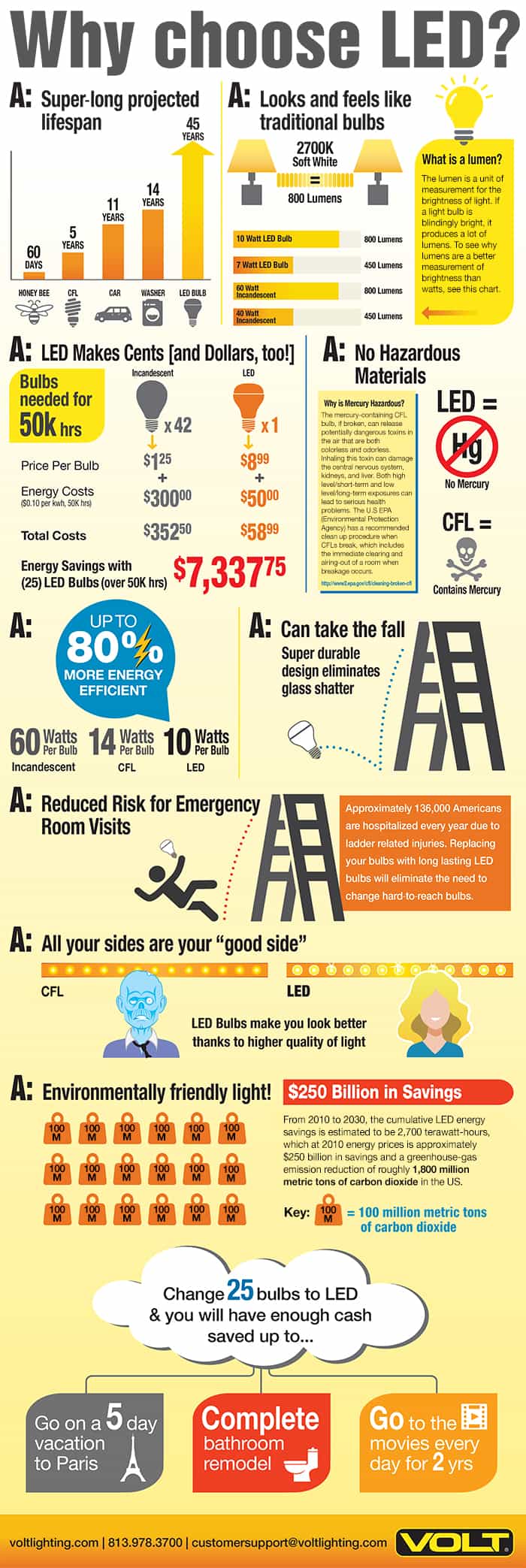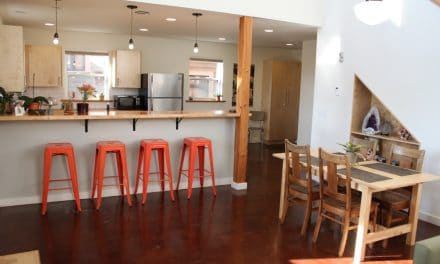by Cory Mercer
With new research on energy consumption emerging all the time, more and more people are looking for different ways to reduce their eco-footprint and become more energy efficient. There are numerous ways to conserve energy at home, with one of the easiest changes being lighting. Lighting is said to be the fourth largest energy consumer in residential homes, contributing to about 10-20% of your overall energy bill, so a simple change to energy-efficient bulbs can go a long way in reducing your household eco-footprint and saving you money.
There are three main types of energy-efficient bulbs: halogen incandescents, compact fluorescent lamps (CFLs), and light-emitting diodes (LEDs). Each has their pros and cons, so we’re going to go over the details of each bulb to show their differences and figure out whether one is better than the others.
Energy consumption
A bulb’s energy efficiency is usually measured by how much energy it requires compared to how much energy is required by a traditional incandescent bulb to produce the same amount of light. For this example, we’re going to compare each bulb to a 60-watt traditional incandescent.
To produce the same amount of light as a 60-watt incandescent, each bulb would require approximately the following amounts of energy:
Halogen incandescent: 42 watts
CFL: 15 watts
LED: 12 watts
In percentages, this means a halogen bulb will use about 25% less energy, CFL about 75% less, and LED about 80% less. Needless to say, CFLs and LEDs take the win here.
Lifespan
Assuming the bulb is on for at least three hours a day, a traditional incandescent bulb is good for about a year or two before it will noticeably dim or go out all together and need a replacement. Will you have the same problem with other bulbs?
A halogen incandescent will have about the same lifespan as its traditional cousin, with projected life sitting around 1,000-2,000 hours (1-2 years). CFLs are significantly better, with the average bulb rated to last around 10,000 hours (9-10 years). LEDs, however, take the cake once again, with the average LED bulb estimated to last around 25,000 hours or more (25+ years).
This is precisely why LEDs are preferred in garages and outdoors (front yard, backyard, etc.); since you often have your lights on for longer in these areas, lifespan becomes a key decision maker in choosing bulbs. And since LEDs also are the most energy efficient, it only enhances their appeal.
Brightness and color
Before energy-efficient bulbs were released, brightness was measured in watts. It made sense at the time – the more watts, the brighter the bulb. However, now that you’ve got bulbs producing the same amount of light with far less wattage required, a new metric is used: lumens.
Thankfully, each type of light is capable of producing any level of brightness from a common household setting (roughly 500 lumens) to a strong backyard setting (1000+ lumens). With that said, there’s really no winner when it comes to overall brightness. The difference here lies in the time it takes to reach full brightness, and the shade of the light itself.
Halogen incandescents and LEDs provide bright, consistent light as soon as you flip the switch, but CFLs usually take a minute or two to reach full brightness and are still known to occasionally flicker even after they’ve been warmed up. Additionally, LEDs and halogens are available in a wide range of hues from warm white to cool blue, whereas CFLs typically fall into the cool blue category.
Price
Compared to traditional incandescent bulbs, energy-efficient bulbs do come at a slightly higher upfront cost. However, not only is the cost increase minimal, but the investment also greatly pays off over time when you do the math and figure out how much you’re saving on energy costs.
For starters, here are the average prices of a regular household bulb of each type:
Halogen incandescent: $1
CFL: $2
LED: $5
As you can see, nothing major. But let’s look at costs over time. Using 25,000 hours, or 25 years, as a base (since that’s the average lifespan of one LED bulb), here are your estimated long-term costs:
Halogen incandescent
Bulb costs: $25 (you’ll need to buy 25 bulbs to match one LED’s lifespan)
Energy costs: $88
CFL
Bulb costs: $5 (you’ll need to buy 2.5 bulbs to match one LED’s lifespan)
Energy costs: $30
LED
Bulb costs: $5
Energy costs: $25
Now, if you looked at those numbers and thought, “That’s not THAT much,” remember – these are all estimates for a SINGLE bulb. According to Energy Star, the average U.S. household has more than 40 bulbs, which means your costs are really as follows (still using 25,000 hours, aka 25 years, as base):
Halogen incandescent
Bulb costs: $1,000
Energy costs: $3,520
CFL
Bulb costs: $200
Energy costs: $1,200
LED
Bulb costs: $200
Energy costs: $1,000
When it comes to cost, it’s clear that CFLs and LEDs are the clear money-savers whereas halogen incandescents are still similar in cost to their traditional cousins.
Conclusion
So, is there one type of energy-efficient light bulb that’s overall “better” than the rest? Absolutely. LED bulbs not only conserve the most energy, but they also last the longest and require the lowest investment over time with both bulb and energy costs considered. CFLs aren’t too close behind, but if you’re looking to replace the bulbs in your house, LEDs should be your priority.

Infographic courtesy of Voltlighting.com.
Author bio
Cory Mercer is a clean energy advocate who aims to raise awareness on energy efficiency to help others reduce their footprint and save some money while they’re at it. His end goal is to provide a positive impact on climate change to prevent any future damage to the planet.





![10 Steps Toward a Zero Energy Home [Infographic]](https://elemental.green/wp-content/uploads/2016/04/cbfb-440x264.jpg)


